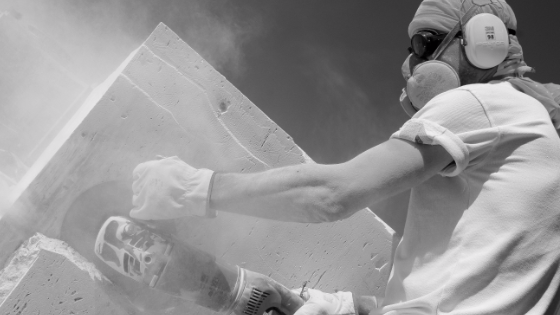What is Silica?
Silica is a hard, unreactive and colourless compound found in rocks, sand and clay and in products such as bricks and concrete. It is also used as filler in some plastics. These materials create dust when they are cut, sanded, carved etc.
The dust is known as Respirable Crystalline Silica (RCS) and, because it’s so fine, it is incredibly difficult to observe under normal lighting. Therefore, it can easily be inhaled into the lungs – causing long-term irreversible damage to a person’s health.
How Can RCS Harm Your Health?
Silica dust represents one of the largest health hazards in the UK workplace because it’s almost impossible to avoid. Occupational exposure can occur in many industries, construction in particular. It is the second-highest risk to construction workers after asbestos, with which it shares many similarities. Dentistry and kitchen bench-top manufacture is another area where silica dust exposure is a very real hazard.
Significant exposure to RCS can lead to silicosis – a very serious lung disease. Silicosis is caused by inhaling large amounts of crystalline silica dust, and in some cases RCS causes lung cancer. It is estimated that exposure to RCS kills around 600 people a year! So how much silica dust a person can be exposed to? And how can this be measured? The answers can be found in the law.
The Limits
Unlike asbestos, RCS doesn’t currently have its own set of regulations but the requirements of COSHH must be applied to any work with a risk of exposure.
The HSE publishes Workplace Exposure Limits (WELs) for certain hazardous substances. WELs are the maximum permitted limits of exposure to any given substance, averaged over a specified period of time. From the 17th January 2020, the fourth edition of WELs came into force, introducing new and revised Workplace Exposure Limits for a number of substances. The release of this edition was in response to the growing understanding of the risks of exposure. These limits aren’t guidelines; they are a legal requirement and businesses must comply with the lower limits.
While the exposure limit for Respirable Crystalline Silica is unchanged and remains at 0.1mg/m³, it has, for the first time, been classified as carcinogenic and ‘capable of causing cancer and/or heritable genetic damage’. Remember – this limit does not signify a safe level of exposure. Any amount of silica dust exposure can be harmful. As silica dust is a substance known to cause cancer, exposure must be reduced to as far below the level as is reasonably practicable.
It is worth noting that other countries have already reduced their exposure limits, with the US limit being 0.025mg/m³, and Australia being 0.05mg/m³.
What Should Employers Do?
In order to comply with the law, employers must carry out COSHH assessments. These should determine the level of risk and the controls needed to reduce it. Minimising the dust at source by using a wet cutting method is an example of a control method, although there are others such as working enclosures and LEV. Where possible, look to use materials with a lower RCS content, and substitute existing higher RCS materials accordingly.
Furthermore, all employees should be provided with personal protection equipment and detailed information regarding the risks to health. Exposure to silica dust must be monitored and measured at all times.
The control measures developed to reduce exposure must keep it as far below the Workplace Exposure Limit as possible.
We’re here to help
At Workplace Exposure, our expert team have experience working with a variety of different businesses to ensure they offer a safe, compliant working environment. Our professional solutions and advice help to ensure your business meets compliance standards and is operating to best practice. If you need help in carrying out a COSHH air monitoring survey to help select the correct PPE, or your workplace noise assessment, we’re here to help.
Our approach
Get in touch with Workplace Exposure, either give us a call on 0800 689 4386, or fill in our enquiry form to discuss your monitoring or consultancy requirements.
We’ll then provide you with a no obligation proposal, we can often give an initial idea of fees whilst we discuss your needs.
Once you’ve accepted our proposal we can then schedule the work.
Following our site visit we’ll provide you with a comprehensive report giving you advice, recommendations and control measures where appropriate.
Implement the outcomes for compliance and a happier healthier workplace.
